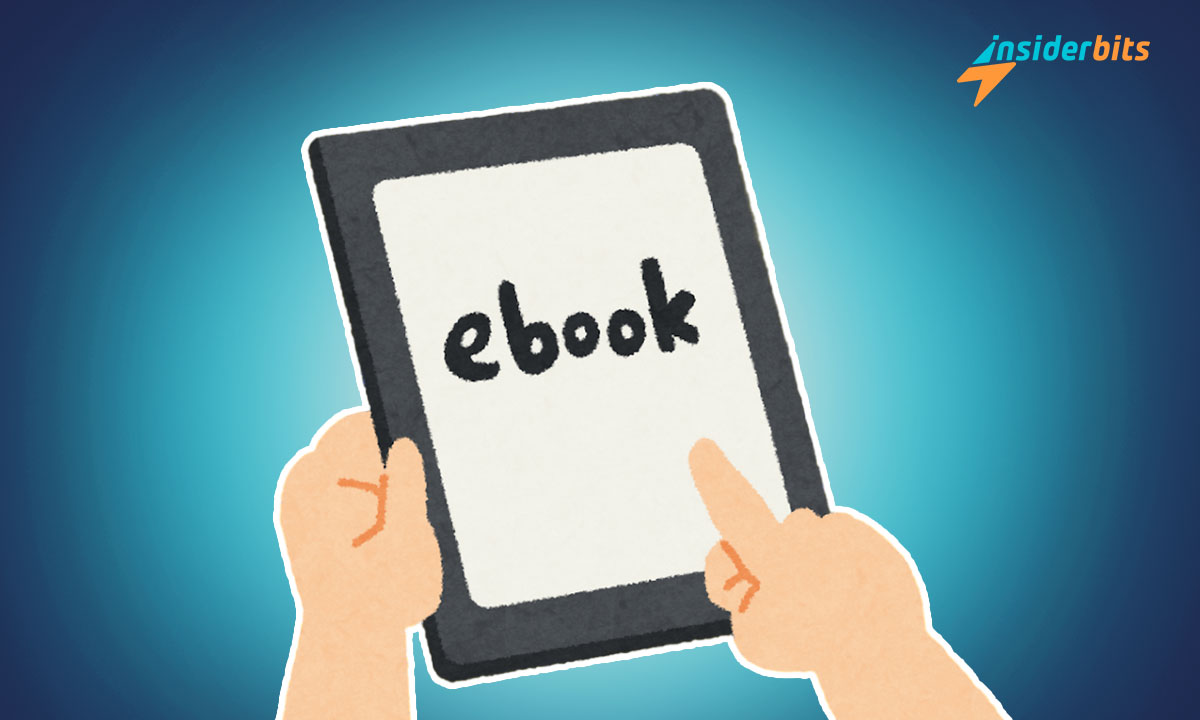Creating an eBook offers endless possibilities for writers. Whether you’re building a guide or telling a story, you have to know how to create an eBook that leaves a lasting impression.
With the help of different apps, you’ll have the tools to shape your eBook vision. These tools simplify everything from structure to layouts, letting you focus on the content and the audience.
With this Insiderbits guide, you’ll unlock the techniques and apps that simplify eBook creation. Ready to bring your project to life? Let’s begin crafting something readers won’t forget!
Related: How To Create Ebooks In Canva 2024
Selecting the Perfect App to Create Your eBook

Choosing the right app to create your eBook is essential for making the process smooth. The right tools can simplify tasks like formatting, design, and final publishing, saving you time.
A good app ensures your eBook looks professional. With features like customizable templates, you can focus on your content while the app handles the technical aspects with ease.
To make the decision easier, we’ve gathered the best options below. These applications offer the tools needed to turn your ideas into a successful eBook. Let’s explore your choices!
Canva
| Available For: | Android and iOS. |
| Pricing: | You can use Canva for free, but a monthly subscription will give you access to a lot more features. Plans start at $14.99. |
4.7/5
Canva offers an intuitive way to create eBook content that looks polished. With its easy-to-use editor, you can add visuals, text, and design elements that fit your eBook’s theme perfectly.
For those new to design, Canva’s templates make it simple to get started. Whether focusing on storytelling or creating a guide, you can adjust fonts, layouts, and images to match your vision.
This platform is perfect for creators who prioritize content but need something to make their eBook visually engaging. Canva’s approach allows anyone to create a professional design.
Scrivener
| Available For: | iOS. |
| Pricing: | $23.99. |
Scrivener is one of the best apps to handle a more complex eBook. It organizes everything, from chapters to research notes, making it easier to keep track of ideas and sections.
Its most notable feature is the ability to export to different eBook formats, like EPUB and MOBI, ensuring your manuscript transitions smoothly from draft to publication without extra software.
If you’re after flexibility, Scrivener allows for the rearranging of sections. Whether you’re planning details or writing in a rush, it adapts to your process while keeping your work organized.
Atticus
| Available For: | Web. |
| Pricing: | A one-time lifetime purchase for $147. |
Atticus is designed with authors in mind, bringing together writing, editing, and formatting in one place. Its clean interface makes it easy to create an eBook from start to finish with little effort.
The app also makes customizing your eBook a lot easier, as it provides ready-made themes that let you control its appearance. This helps even new authors achieve professional results.
Since Atticus is cloud-based, your work stays accessible across devices. This makes it a solid choice for authors looking to keep their work handy, no matter where they’re working from.
Related: How To Use Google Docs Voice Typing On Mobile And Desktop Devices
Pro Tips on How to Design an Engaging eBook Layout

Now that you know the best apps to create an eBook, it’s time to focus on the layout. A well-designed layout is crucial to keeping readers engaged and making content flow smoothly.
A captivating eBook layout guides readers through your content. By using balanced spacing, clear typography, and visual elements, your eBook becomes more inviting and easy to follow.
Ready to bring your eBook to life with professional design? Keep reading to discover essential tips that will help you create a layout that captures your audience’s attention from start to finish.
Use Visual Hierarchy to Guide Readers
A visual hierarchy helps readers navigate your eBook. Clear distinctions between headings, subheadings, and bodies using different font sizes create an organized reading experience.
When you create an eBook, make sure that key information stands out. Larger or bold fonts for important points guide readers’ attention, while smaller fonts help maintain a clean layout.
Maintain balance in your hierarchy by ensuring there’s a natural flow to the content. This creates a sense of order, making your eBook content easy to follow and understand.
Leverage White Space for Clarity
White space is essential for an eBook’s readability. It prevents clutter and gives readers’ eyes space to breathe, making the content more comfortable and pleasant to engage with.
Many eBook apps allow you to adjust margins and spacing effortlessly. Use this feature to your advantage, creating a balance between text and visuals so that it feels polished and professional.
Overcrowding your pages can overwhelm readers. Thoughtfully placed white space highlights key elements and ensures the content remains inviting, making your eBook easier to read.
Incorporate Visuals to Enhance Understanding
Visuals are a powerful way to break down complex information. Infographics, charts, and images can clarify ideas, making them easier for readers to grasp while adding a visual interest.
As you create an eBook, consider using design tools to add these elements. They offer a range of customizable templates that make adding visuals straightforward, even for beginners.
Remember that balance is key! Too many visuals can distract from your message, but thoughtful placement helps engage readers without overwhelming them.
Add Interactive Elements for Engagement
Interactive features like quizzes, hyperlinks, and videos can enhance the reader’s experience. These elements transform a static eBook into an interactive learning or entertainment tool.
Many eBook apps support interactive elements. Use them to add depth to your eBook, whether through additional resources, quizzes, or clickable content that enriches the reading experience.
An eBook with interactive elements keeps functionality simple and intuitive. Readers should be able to engage with the content effortlessly, whether they’re on a desktop, tablet, or mobile.
Optimize Your eBook for Mobile Devices
Most readers will access your eBook on mobile devices, so it’s crucial to make it look great on smaller screens. Text, images, and features should be responsive and easy to navigate.
Pay attention to font size and button placement. What works on a desktop may need adjustments for mobile. Check that the app you’ve chosen offers preview modes to refine this.
By optimizing for mobile, you ensure your eBook remains engaging on any device. A responsive layout, adjusted fonts, and well-placed visuals create a smooth experience for mobile readers.
Related: How to Access and Use ChatGPT 4o for Free
How to Distribute Your eBook for Free Online

Distributing your eBook for free at first can boost your visibility. When you create eBook content, offering it at no cost allows readers to discover your work without any barriers or hesitation.
This strategy helps build a loyal audience. By giving away your eBook, you’re encouraging readers to engage with your writing, leaving reviews, and sharing it with others.
To maximize your reach, there are strategies and apps you can use to share your eBook. See below to learn some essential methods that will help you get your content into the right hands.
Use eBook Platforms to Reach a Wider Audience
Publishing your eBook on platforms like Smashwords or Draft2Digital allows for broader exposure. These services simplify distribution, helping you create an eBook and share it freely.
Offering your eBook on these platforms encourages downloads, which boosts visibility. With access to many online stores, your eBook has a greater chance of reaching interested readers.
These platforms take care of the technical side, freeing you to focus on marketing and connecting with your audience, helping your eBook reach its full potential without added stress.
Leverage Social Media to Promote Your eBook
Social media is an excellent way to share your free eBook with a wide audience. Platforms like Instagram, Twitter, and Facebook allow you to engage readers through posts and previews.
Offering your eBook for free in these apps helps grow your reader base quickly. Engage with your audience by hosting giveaways or sharing behind-the-scenes content about your book.
You can use hashtags and direct links to drive traffic to your eBook. Social media keeps your content visible and creates ongoing excitement around your new release or project updates.
Create an eBook Landing Page
Building a landing page makes it easy to access your eBook directly. When you create an eBook, having a dedicated page allows for simple downloads and efficient email collection.
Platforms like Mailchimp offer customizable landing pages that allow you to gather sign-ups while offering your eBook for free. This way, readers can stay connected for future releases.
A landing page helps you establish a direct line to your audience with consistent engagement. It also enables you to track downloads and build a stronger relationship with readers.
Related: How to use Canva for free?
Publish and Share Your eBook with Confidence
Making an eBook can be a simple and rewarding process with the right tools. From choosing the best platform to formatting your content, these tips help you create an eBook with ease.
Using eBook apps to streamline design, formatting, and distribution saves time and ensures a professional look. These tools are designed to help you build an engaging final product.
This guide by Insiderbits has offered practical advice on how to create and distribute an eBook. With these strategies, you’re ready to publish and share your work confidently and successfully.
Keep exploring Insiderbits for more helpful tips, tech tools, and inspiration. Whether it’s creativity or productivity, we provide resources that empower you to bring your ideas to life.





